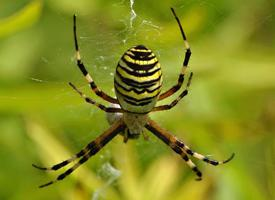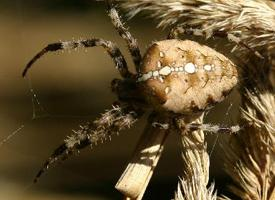
Váhy a míry
| Délka | od 4 do 15 mm |
|---|
Popis zvířete
The Wasp Spider (Argiope bruennichi), named for its striking resemblance to wasps, is a fascinating species of orb-weaver spider that has captivated the interest of both arachnologists and nature enthusiasts alike. This species belongs to the family Araneidae and is primarily found across Europe, North Africa, parts of Asia, and has been increasingly spotted in other regions, suggesting a range expansion, possibly due to climate change.One of the most distinctive features of the Wasp Spider is its vibrant and bold coloration. The abdomen is predominantly a bright yellow or sometimes white, adorned with black transverse bands, mimicking the appearance of a wasp. This remarkable mimicry is not just for show; it serves as an effective deterrent against predators, leveraging the common aversion many animals have towards wasps and their painful stings. The cephalothorax, in contrast, is a more subdued silver-grey color, and the legs are adorned with fine black and yellow banding, further complementing the wasp-like illusion.
Adult females are considerably larger than males, with their body length reaching up to 15mm, whereas males typically measure about 5mm. The size disparity between the sexes is one of the most pronounced in the spider world, leading to a fascinating, albeit perilous, mating process for the males.
The Wasp Spider constructs its web in tall grasses and low shrubbery, preferring sunny, sheltered areas. The web itself is a work of art and engineering, featuring a distinctive zigzag pattern of silk known as the stabilimentum down the center. The function of the stabilimentum is still a subject of scientific debate, with theories suggesting it may serve to attract prey, provide structural stability, or act as a warning to birds and larger animals to avoid damaging the web.
Diet-wise, the Wasp Spider preys on a variety of insects that blunder into its web. Once a victim is ensnared, the spider quickly immobilizes it with a venomous bite and wraps it in silk, consuming it at leisure. This diet helps control the populations of pest insects, highlighting the Wasp Spider's role in maintaining ecological balance.
Reproduction takes place in late summer. After mating, the female lays her eggs in a silken sac, which she attaches to vegetation. The sac is camouflaged and protected against predators and the elements. Come winter, the adult spiders typically die, leaving the next generation to hatch in the spring and continue the cycle.
Despite their fierce appearance, Wasp Spiders are not aggressive towards humans and will only bite if severely provoked. The bite may cause mild discomfort but is generally harmless, lacking the potency of a true wasp sting.
In conclusion, the Wasp Spider (Argiope bruennichi) is a remarkable example of mimicry in nature, blending artistry, cunning, and an important ecological role into one striking package. Its presence in the ecosystem is a testament to the intricate balance of nature and the fascinating adaptability of arachnids.
Podobná zvířata
Nové fotografie zvířat
Top 10 zvířat
- Chinese water dragon (Physignathus cocincinus)
- Galápagos tortoise (Geochelone nigra complex)
- Dolphin gull (Leucophaeus scoresbii)
- Japanese macaque (Macaca fuscata)
- Colombian red howler (Alouatta seniculus)
- Sea urchins (Echinoidea)
- Diana monkey (Cercopithecus diana)
- Moustached guenon (Cercopithecus cephus)
- Common reed warbler (Acrocephalus scirpaceus)
- Common house mosquito (Culex pipiens)
